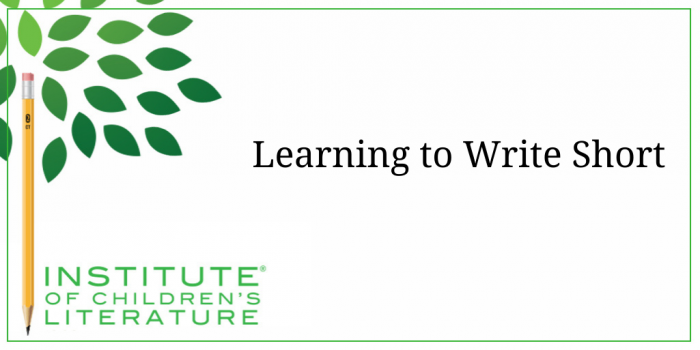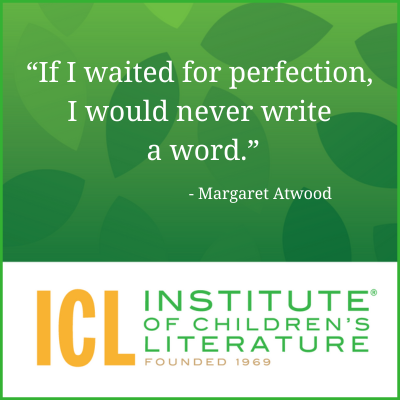1000 N. West Street #1200, Wilmington, DE 19801
© 2024 Direct Learning Systems, Inc. All rights reserved.

There’s a famous quote attributed to Blaise Pascal:
“I have made this letter longer than usual, only because I have not had the time to make it shorter.”

Anyone who has tried to create a lively poem to capture the imagination and attention of a child knows that writing short is hard.
Anyone who has ever tried to write to the short story word counts of most children’s magazines knows that writing short is hard.
It also tends to be an integral part of being a children’s writer. So hard or not, it’s worth learning to do well.
I’ve heard novelists say that they’d never try a short story. It’s just too … hard. But a short story is a wonderful laboratory for learning to write plot, characterization, theme and dialogue. If you can build a fully realized story in the tight word counts of short fiction, then novel writing becomes much, much easier. Some of the most amazing short story writers, whether Kurt Vonnegut, Stephen King, or Ray Bradbury, also wrote amazing novels. So writing short (whether short stories or poetry or picture books) has value even if treated as an exercise. It simply makes you better. But it can also be frustrating, so here are some things that can help you learn to write short better.
I’m the world’s worst multitasker in real life. If you try to carry on a conversation with me while I’m putting on my shoes, I’ll probably put them on the wrong feet or tie my laces together. But I have learned how to make things in my writing do more than one job. For instance, for a scene in your story to feel real and believable, it will need: action, setting, dialogue, emotion, and sensory detail. When you’re trying to write a kid’s story in 150 words, it can feel impossible to include everything you need, unless you learn to multitask. Look at the following sentence:

Now what does that sentence do? It gives us setting. We’re pretty sure Joe is not at home where there are no lockers. Nor is he at church or in the park. Since this is a kid’s short story, the reader would immediately mentally set the scene in a hallway full of lockers. So one demand the sentence fulfills is setting.
What else does it do? It has action driven by the main character, and it has a certain amount of emotional force. Now, maybe Joe is a kid who just slams things. But this is extreme. He slams it so hard is bounces back open and smacks him. That suggests emotion charging the action. And it shows us something about Joe. He responds to his feelings with action. Plus, we get a bonus because it offers a little piece of slapstick. Poor Joe, trying to work off some frustration and catching a face full of cold, hard locker.
One of the benefits of that sentence is that I can now have a scene without making another reference to setting, because readers bring along all of the images we carry associated with schools and lockers. I also have caught the reader’s interest. Didn’t reading it make you wonder just a bit about what happened to poor Joe?
When you look at the sentences you write for short stories, and even for picture books and poetry, nearly every line should be doing more than one thing. Really, I shoot for every line.
Even though I’ve written dozens of short stories in my career, I still usually write too long the first time. Then I have to cut. One of the first things I do when I have to cut words from a really short piece is simply to go through, sentence by sentence, and take out at least one word. It’s a rare sentence that can’t lose a word. And sometimes, I can lose a whole sentence if I realize it’s reproducing information either implied by the text or imagined by the reader. For example, look at this:
From the kitchen, Joe heard his dog outside. “Ruff, Ruff, Grrrr,” his dog barked and growled. “Ruff, Ruff, Grrr.” Joe ran out the back door to see what the dog was barking at.

“Ruff, Ruff, Grrr.”
Joe ran outside. “What’s wrong Spot?”
That’s how picture books tend to work because much of the multitasking is done by illustrations, so you don’t need to do it in the text. If I were writing a short story for fluent readers (in a magazine like Cricket, for example), I would have cut down that redundancy quite differently. It might have looked like this:
When Spot barked and growled from the backyard, Joe ran out to check on him.
In either case, I look at the goal of the sentence, what it’s meant to convey to the reader. I look at the sentences around it for redundancy. Then I hone the text to be leaner and stronger. You remember the sentence about Joe’s locker? If I were taking my pruning shears to it because my story was too long, I would probably cut it like this:
“Joe slammed his locker. It bounced back, smacking him in the nose.” Do you see why? The words “so hard” are really implied by the fact that it bounced back and slammed him in the nose, so I could lose those two if necessary.
One great way to write short is to write your synopsis of your story before you write the story. This lets you know what the structure of your plot looks like before you launch into it. That can help you tell the best moment to enter the story, the best moment to leave the story, and the best way to avoid pointless side trips during the story. For instance, I once wrote a story that could be condensed into this synopsis:
“After a fight with his best friend, Joe wants to make up but he doesn’t know how until a memory of their favorite game sparks a creative solution.”

“Joe stomped off to his room. He read for a while and drew a picture and practiced his magic tricks, and didn’t mind at all that he wasn’t playing with Ben.”
By listing an interesting collection of activities I manage to show the passage of time while still engaging the reader, and even adding a bit of characterization. Even though the text says that Joe didn’t mind at all that he wasn’t playing with Ben, we’re not totally sure we believe him. The narrative doth protest too much. And so when we transition into Joe running out of things to do and looking out the window at the half finished snowman, we are fully ready to feel Joe’s regret at the fight.
When you want to accomplish a story or a picture book or even a poem, there are few more helpful ways to write short than to do the synopsis first. It will let you focus before ever putting the first word on the page and that will lead to fewer words being cut later. Writing short does take effort, but something surprising happens when you do it. Your focus on those few words can help you learn to make them the very best words. And the ability to write strong, clear, powerful prose is the gift that will keep on giving, no matter what you go on to write.
With over 100 books in publication, Jan Fields writes both chapter books for children and mystery novels for adults. She’s also known for a variety of experiences teaching writing, from one session SCBWI events to lengthier Highlights Foundation workshops to these blog posts for the Institute of Children’s Literature. As a former ICL instructor, Jan enjoys equipping writers for success in whatever way she can.
1000 N. West Street #1200, Wilmington, DE 19801
© 2024 Direct Learning Systems, Inc. All rights reserved.
1000 N. West Street #1200, Wilmington, DE 19801
© 2024 Direct Learning Systems, Inc. All rights reserved.
1000 N. West Street #1200, Wilmington, DE 19801
© 2024 Direct Learning Systems, Inc. All rights reserved.
1000 N. West Street #1200, Wilmington, DE 19801
© 2025 Direct Learning Systems, Inc. All rights reserved.
1000 N. West Street #1200, Wilmington, DE 19801
©2025 Direct Learning Systems, Inc. All rights reserved. Privacy Policy.
1 Comment